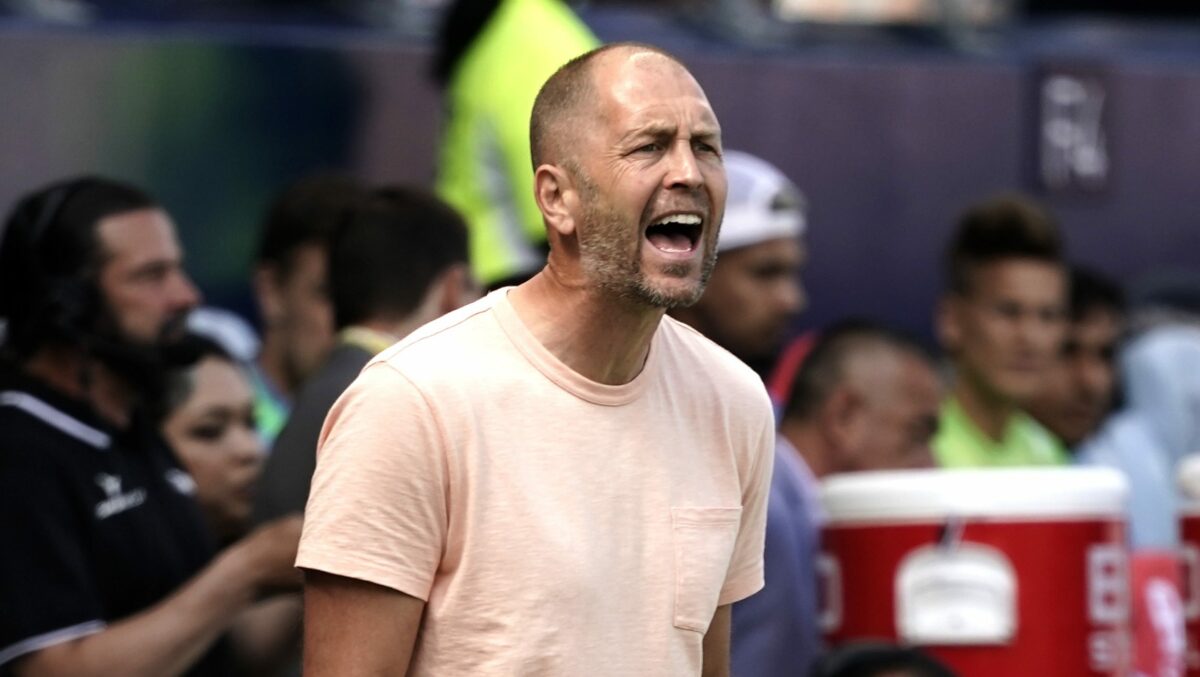The U.S. men’s national team battled Uruguay to a scruffy, scrappy 0-0 draw in Kansas City Sunday night. And we do mean “battled,” as La Celeste brought their traditional intensity at Children’s Mercy Park, and the USMNT matched them tackle for tackle in that department.
What neither team brought was clinical finishing, with Jesús Ferreira and Edinson Cavani both missing golden chances. Multiple other players sent inviting chances right at goalkeepers Sean Johnson and Fernando Muslera, resulting in a scoreless draw that both teams will feel like they could have won.
Here are the three most noteworthy moments from this one:
Ferreira leaves the door open
Ferreira has been spectacular in MLS this season, and among a pool of center forwards that largely play traditionally, Ferreira’s ability to drop off the front line and combine is a big deal. Christian Pulisic and Tim Weah are likely the team’s top marksmen in Qatar, and they’ll be helped by Ferreira’s ability to combine and open up space for them to slash into off the wings.
But…you do want to see point-blank chances buried by your No. 9. Any wannabe tactical guru can talk you to death about overloads, half-spaces, and the like, and Ferreira was actually quite good in this game in the thankless task department. Still, people—regular fans, soccer nerds, and USMNT coaching staff members—want the ball to be kicked or otherwise directed into the goal.
y'all are gonna destroy Jesus Ferreira for not scoring but:
– this is a brilliant USMNT move, and Ferreira played the second-most important role in it, after Musah
– Yedlin *has* to keep this lower. And if he does, it's probably a goal pic.twitter.com/4cgtymSzta— Henry Bushnell (@HenryBushnell) June 5, 2022
Ferreira draws multiple defenders before getting the ball off his feet and into space for Yunus Musah, and then loses Martín Cáceres at the back post. That’s good work that we don’t see from other forwards in the USMNT pool as often, and it’s not the best ball in from DeAndre Yedlin. But still, to go through in a balanced Group B, this chance has to go in, no excuses.
“It was more the finishing attacks phase of the game that we struggled in,” Berhalter said of his forwards in the post-game press conference. “We got the ball into really good positions, and then just didn’t take advantage of that … I think there were moments—Jesús had another really good chance—there were moments where we came up a little bit short.”
Ferreira deserves some grace because we can see his play in MLS, we can see the goals he is scoring, and we know that he can put the ball away. They’re still playing with standard-sized goals in Qatar, and the World Cup ball is made by the same company that manufactures the MLS game ball. He’s good!
But still, he hasn’t distanced himself from the pack of strikers all eyeing this starting job up in a USMNT shirt, and until he (or anyone else) does, we’re going to be talking about the situation up top.
Aaronson good in midfield again
Brenden Aaronson checked into this game at halftime for Weston McKennie, a move Gregg Berhalter said was planned before the match. After a successful appearance as part of the midfield trio against Morocco, Aaronson slotted right into McKennie’s place, joining Musah and Tyler Adams in what we’re going to have to start calling the AMA midfield if they keep working as a trio.
Because, so far, they are working as a trio. There’s a classic balance of roles that are required in a midfield: regardless of how you distribute the duties between your defensive midfielder, box-to-box midfielder(s), and your attacking midfielder, you need a ball-winner, a passer, and someone who can make attacking runs. Perhaps even moreso than McKennie, who is somewhere between ball-winner and runner, Aaronson fits that third role perfectly.

In truth, the USMNT struggled to keep pace with Uruguay from an intensity standpoint early, with the withering high press and hard tackles not really being matched until around the 15th minute. Aaronson stepped into a game that was frenetic, and actually drove the USMNT tempo higher on both sides of the ball, no small feat for a halftime substitute.
The moment that underlines this is also a bit farcical: a couple of minutes into the half, he and Manuel Ugarte both collided going after a loose ball, with Aaronson eventually drawing a foul after his shoelace became entangled with Ugarte’s studs.
That's not something you see everyday 🤣 pic.twitter.com/cIRcLnRXQY
— FOX Soccer (@FOXSoccer) June 5, 2022
It was a unique foul, but it only happens because Aaronson is playing in such a controlled hurry to go after the ball that he drew the attention of the referee. That urgency helped the USMNT in the end, and it’s potentially hugely important for Berhalter to have Aaronson as a potentially starting-caliber option in this role as well as on the front line.
Things got weird!
The shoelace tackle was odd, but was more or less forgotten when Uruguay made a seventh substitution in the 68th minute. FIFA regulations for valid international friendlies restrict teams to six substitutions, but Diego Alonso made a double sub when he’d already used five.
This didn’t really actually matter. The result didn’t change, Facundo Pellistri didn’t save any goals from being scored, and on the touchline everyone seemed to work out a solution (give the USMNT one more sub) that didn’t even end up coming into use.
It’s more than a little silly that friendlies have a substitution limit, since the games already tend to lose their rhythm (the whole reason FIFA instituted a limit in the first place) when two teams can replace over half of the players that started a given game. But it’s also a reflection of the ragged second half in hot conditions that this counting error, rather than goals or passes, became a major talking point.
[lawrence-related id=2824,2820,2800]
